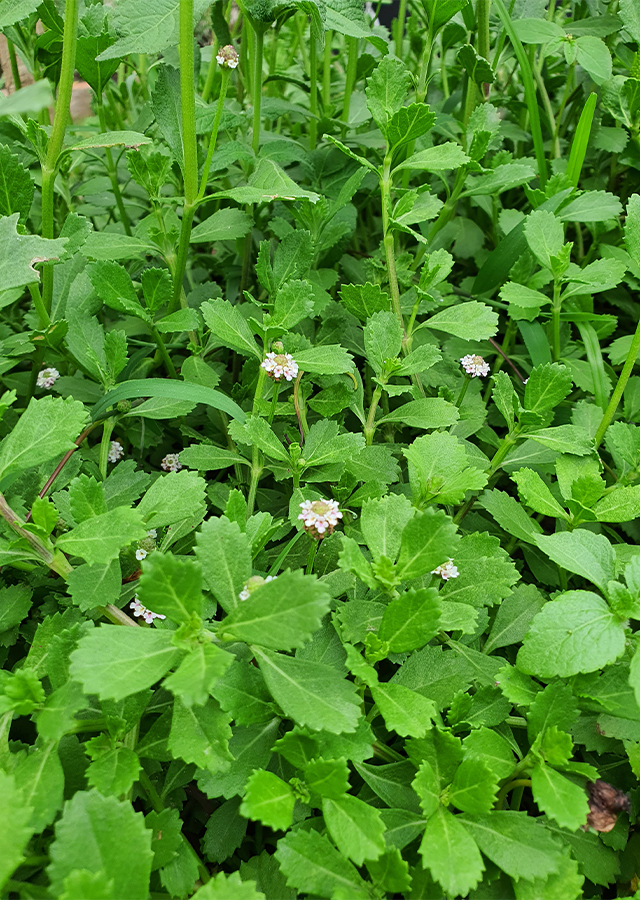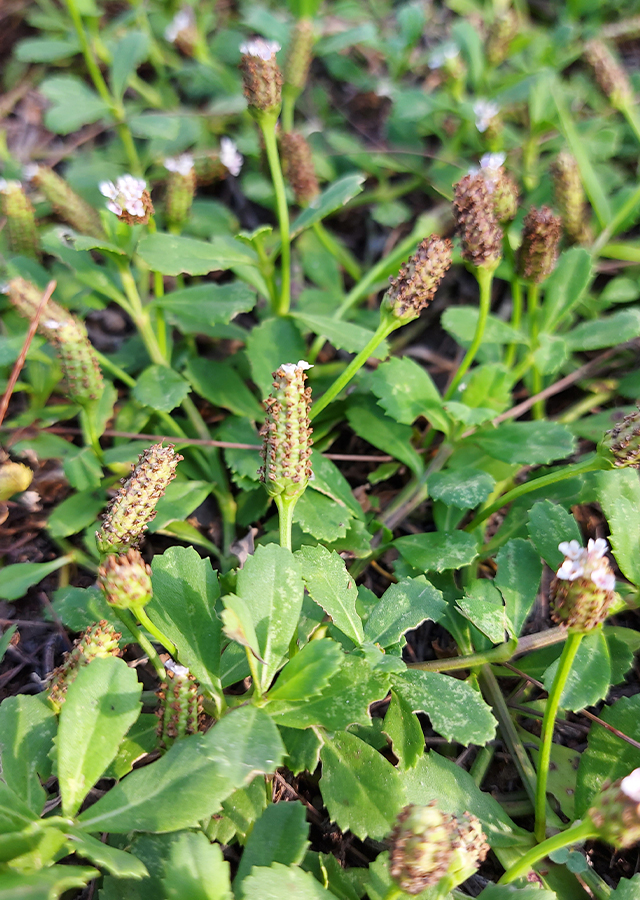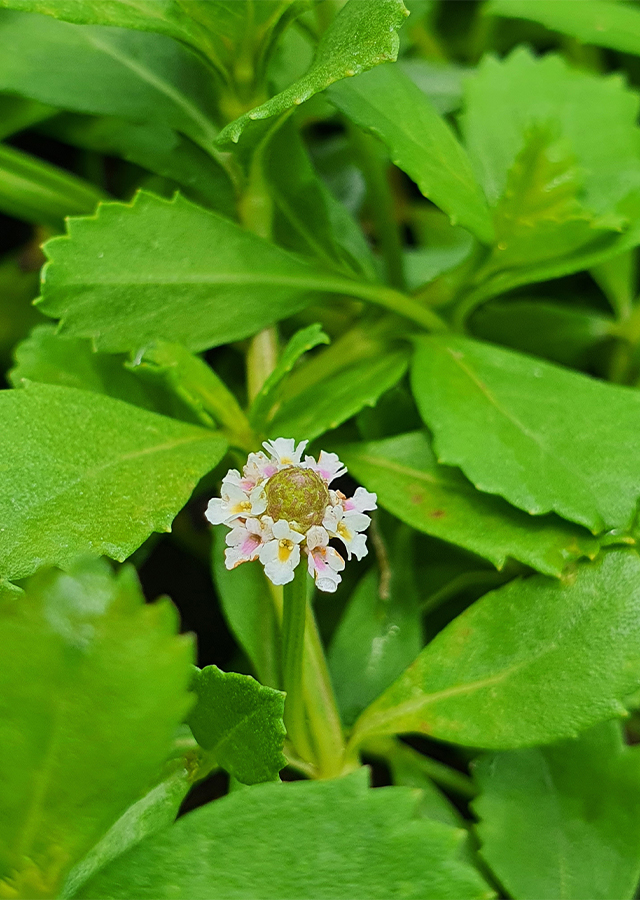Frogfruit
Phyla nodiflora (L.) Greene
Verbenaceae
Location in our garden
Beneficial Weed



Synonym
Blairia nodiflora (L.) Gaertn.
Lippia nodiflora (L.) Michx.
Platonia nodiflora (L.) Raf.
Habitus
Herbaceous. A low growing, herbaceous, perennial plant with slender often purplish stems extend from 15-30 cm
Part Used
The Whole Plant
Growing Requirements
Full Sunshine
Need Shade
Drought Resistant
Habitat
Riverbanks
Coastal
Roadside
Grassland
Overview
Frogfruit is an ornamental plant, which is native to Brazil and United States. It can be found in tropical areas around the globe, a naturalized species in many places. It is an important member of the family Verbenaceae showing a variety of medicinal uses. It can be the source of indigenous medicine. The IUCN status conservation is Least Concern.
Vernacular Names
Busbusi (Tagalog-Philippines), Ya kelt pla (Thai), D[aa]y l[uws]c (Vietnamese), Man am ca dam (Cambodian), Pa zun tha bet (Burmese), Grodverbena (Swedish), Erba Luigia Minore (Italian), Verveine Nodiflore (French).
Agroecology
P. nodiflora succeeds in a wide range of habitats from the subtropics to the tropics. It grows along stream banks, in grassy places, and near the coast at elevations of 300-2,300 m. Succeeds in any well-drained soil in a sunny position. Prefers a moderately fertile soil, but succeeds in soils of low fertility, and it is drought tolerant.
Morphology
- Stems - usually purplish, flat with ridges when young, long covered with fine medifixed hairs.
- Leaves - numerous, nearly without stalks, obovate, 1 to 2.5 cm long, with blunt or rounded tip and wedged-shaped base; margins on the upper half are sharply toothed. Spikes appear at the ends of stalks, growing singly from the axils of the leaves.
- Flowers - very small, pink or white, crowded in ovoid or cylindric spikes, 1-2.5 cm long and about 6 mm in diameter. Corolla consists of a slender and cylindric tube, about 3 mm long, with a limb 2.5 mm wide, opening at the apex as it lengthens.
- Fruits – oval, 1-1.5 mm in diameter, release two tiny brown.
- Seeds - barely visible to the naked eye, flattened seeds at maturity.
Cultivation
- Generative propagation is done by seeds - sowing the seed in a greenhouse in the middle of spring. When they are large enough to handle, prick the seedlings out into individual pots and plant them out in late spring or early summer.
- Vegetative propagation is done by division.
Chemical Constituents
Triterpenoid, alkaloids, flavonoid, phenol, steroid, nodofloretin, glycosides-nodiflorin A, nodiflorin B, lippiflorin A, tannin, rutin, β-Sitosterol, luteolin, nepetin, batatifolin, hispidulin, larycitrin, stigmasterol.
Traditional Medicinal Uses
Medicinal Uses
- The plant is used to treat ulcers, anti-inflammatory, anti-cancer, anti-tumor, anti-malarial, anti-fungal, antipyretic, anodyne, antibacterial, astringent, carminative, deobstruent, diuretic, emmenagogue, emollient, febrifuge, parasiticide, and refrigerant.
- It is useful in the treatment of gonorrhea, lithiasis, ischuria, constipation and pain in the knees, and the treatment of hookworm.
Traditional Uses
- The juice of the plant is cooling, and is used to relieve minor gastric troubles, fevers, coughs and colds.
- The aroma of the inhaled plant is breathed in to treat coughs and colds.
- A poultice of the fresh plant is applied to ripen boils. A paste or poultice is also applied to swollen cervical glands, to erysipelas, burns, and to chronic indolent ulcers.
- The juice of the root is used in the treatment of gastric troubles
- In Pakistan, crushed fresh plant mixed with water and drained, taken on an empty stomach daily for about one week for hemorrhoids.
- In Philippines, infusion of leaves is used as carminative and diuretic.
Part Used
Reference Sources
- Ahmed, A.B.A., Gouthaman, T., Rao, A.S. and Rao, M.V. 2005. Micropropagation of Phyla nodiflora (L.) Greene: An important medicinal plant. Iranian Journal of Biotechnology 3(3) : 186-190.
- California Native Plant Society. (No date). Common Lippia-Phyla nodiflora. https://calscape.org/Phyla-nodiflora-(). 13-11-2020.
- Fern, Ken. (2014). Useful Tropical Plants: Phyla nodiflora. http://tropical.theferns.info/viewtropical.php?id=Phyla+nodiflora. 13-11-2020.
- Sharma, R.A. and Singh, R. (2013). A Review on Phyla nodiflora Linn.: A Wild Wetland Medicinal Herb. Int. J. Pharm. Sci. Rev. Res. Vol. 20(1): 57-63. https://globalresearchonline.net/journalcontents/v20-1/11.pdf. 11-02-2021.
- Stuart Xchange. (2015). Philippines Medicinal Plants: Busbusi-Phyla nodiflora (L.), Greene. http://www.stuartxchange.org/Busbusi. 13-11-2020.

